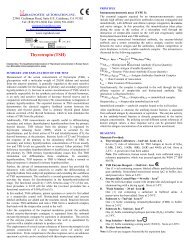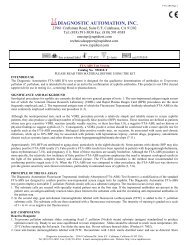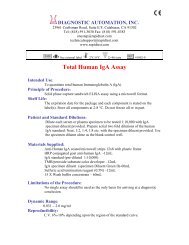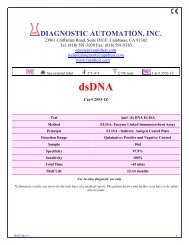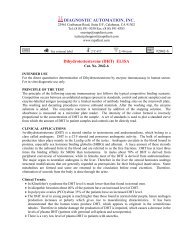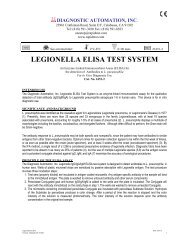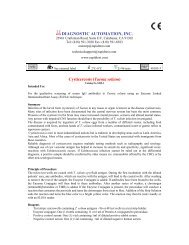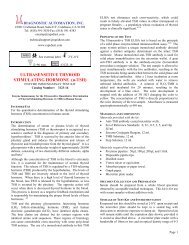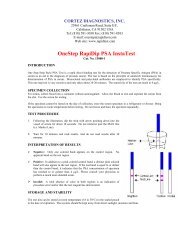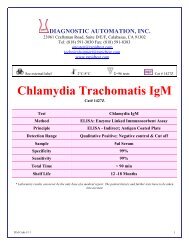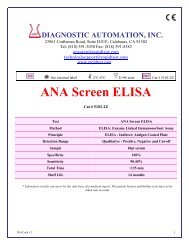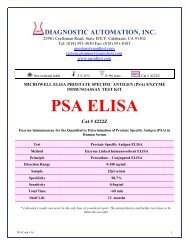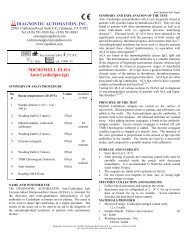TROPONIN I (HUMAN CARDIAC-SPECIFIC) ELISA ... - Diagnostic Kit
TROPONIN I (HUMAN CARDIAC-SPECIFIC) ELISA ... - Diagnostic Kit
TROPONIN I (HUMAN CARDIAC-SPECIFIC) ELISA ... - Diagnostic Kit
Create successful ePaper yourself
Turn your PDF publications into a flip-book with our unique Google optimized e-Paper software.
<strong>TROPONIN</strong> I (<strong>HUMAN</strong> <strong>CARDIAC</strong>-<strong>SPECIFIC</strong>) <strong>ELISA</strong><br />
Catalog Number: 1105<br />
DIAGNOSTIC AUTOMATION, INC.<br />
23961 Craftsman Road, Suite E/F,<br />
Calabasas, CA 91302<br />
Tel: (818) 591-3030 Fax: (818) 591-8383<br />
onestep@rapidtest.com<br />
technicalsupport@rapidtest.com<br />
www.rapidtest.com<br />
See external label<br />
Σ=96 tests #1105<br />
2°C-8°C<br />
Enzyme Immunoassay for the Quantitative<br />
Determination of Cardiac-Specific<br />
Troponin-I in Human Serum<br />
FOR IN VITRO DIAGNOSTIC USE<br />
Store at 2 to 8°C.<br />
PROPRIETARY AND COMMON NAMES<br />
Human Cardiac-Specific Troponin-I Enzyme Immunoassay<br />
(cTnI <strong>ELISA</strong>)<br />
INTENDED USE<br />
The cTnI <strong>ELISA</strong> is intended for the quantitative<br />
determination of cardiac troponin I in human serum.<br />
Measurement of troponin I values are useful in the evaluation<br />
of acute myocardial infarction (AMI).<br />
SUMMARY AND EXPLANATION OF TEST<br />
Troponin is the inhibitory or contractile regulating<br />
protein complex of striated muscle. It is located periodically<br />
along the thin filament of the muscle and consists of three<br />
distinct proteins: troponin I, troponin C, and troponin T. 1-5<br />
Likewise, the troponin I subunit exists in three separate<br />
isoforms; two in fast-twitch and slow-twitch skeletal muscle<br />
fibers, and one in cardiac muscle. 6-8 The cardiac isoform<br />
(cTnI) is about 40% dissimilar, has a molecular weight of<br />
22,500 daltons, and has 31 additional amino acid residues<br />
3-4,8-12<br />
that are not present on the sk eletal isoforms.<br />
Antibodies made against this cardiac isoform are<br />
immunologically different from antibodies made against the<br />
other two skeletal isoforms, 10,13 and the unique isoform and<br />
tissue specificity of cardiac troponin I is the basis for its use<br />
as an aid in the diagnosis of acute myocardial infarction<br />
(AMI). 2-4,8-9,13-17<br />
Cardiac troponin I (cTnI) has been useful in the<br />
differential diagnosis of patients presenting to Emergency<br />
18-20<br />
Departments (ED) with chest pain. Myocardial<br />
infarction is diagnosed when blood levels of sensitive and<br />
specific biomarkers, such as cardiac troponin, the MB<br />
isoenzyme of creatine kinase (CK-MB), and myoglobin, are<br />
increased in a clinical setting of acute ischemia. 21-22,23<br />
The most recently described and preferred biomarker for<br />
myocardial damage is cardiac troponin (I or T) 23 . The<br />
cardiac troponins exhibit myocardial tissue specificity and<br />
high sensitivity. Likewise, cardiac TnI and CK-MB have<br />
similar release patterns (4-6 hours after the onset of pain),<br />
but the level of cTnI remains elevated for a much longer<br />
period of time (6-10 days), thus providing for a longer<br />
window of detection of cardiac injury. 23-24<br />
Normal levels of cTn I in the blood are very low. After<br />
the onset of an AMI, cTnI levels increase substantially and<br />
are measurable in serum within 4 to 6 hours, with peak<br />
concentrations reached in approximately 12 to 24 hours after<br />
infarction. 24-28 The<br />
fact that cTnI remains elevated in serum for a much longer<br />
period of time, added to its enhanced diagnostic sensitivity<br />
and cardiac specificity, allows for the detection of AMI much<br />
earlier after the onset of ischemia (4 hours), 1,25 as well as the<br />
diagnosis of peri-operative infarction in situations where a<br />
high serum level of skeletal muscle proteins are expected. 17<br />
Additionally, recent data have identified a measurable<br />
relationship between cardiac troponin levels and long-term<br />
outcome after an episode of chest discomfort. 24,29 The<br />
studies suggest that the use of the cTnI demonstrates high<br />
predictive value in delineating the high risk group of unstable<br />
angina patients, 30 and that these tests may be particularly<br />
useful in evaluating patient condition prior to discharge from<br />
the ED. 25,29,31<br />
The cTnI Enzyme Immunoassay provides a rapid,<br />
sensitive, and reliable assay for the quantitative measurement<br />
of cardiac-specific troponin I. The antibodies developed for<br />
the test will determine a minimal concentration of 1.0 ng/ml,<br />
and there is no cross-reactivity with human cardiac troponin<br />
T or skeletal troponin T or I.<br />
PRINCIPLE OF THE ASSAY<br />
The cTnI <strong>ELISA</strong> test is based on the principle of a solid<br />
phase enzyme-linked immunosorbent assay. The assay<br />
system utilizes four unique monoclonal antibodies directed<br />
against distinct antigenic determinants on the molecule.<br />
Three mouse monoclonal anti-troponin I antibodies are used<br />
for solid phase immobilization (on the microtiter wells). The<br />
fourth antibody is in the antibody-enzyme (horseradish<br />
peroxidase) conjugate solution. The test sample is allowed to<br />
react simultaneously with the four antibodies, resulting in the<br />
troponin I molecules being sandwiched between the solid<br />
phase and enzyme-linked antibodies. After a 90-minute<br />
incubation at room temperature, the wells are washed with<br />
water to remove unbound-labeled antibodies. A solution of
tetramethylbenzidine (TMB) Reagent is added and incubated<br />
for 20 minutes, resulting in the development of a blue color.<br />
The color development is stopped with the addition of 1N<br />
hydrochloric acid (HCl) changing the color to yellow. The<br />
concentration of troponin I is directly proportional to the<br />
color intensity of the test sample. Absorbance is measured<br />
spectrophotometrically at 450 nm.<br />
REAGENTS AND MATERIALS PROVIDED<br />
1. Antibody-Coated Wells (1 plate, 96 wells)<br />
Microtiter wells coated with mouse monoclonal anti-<br />
TnI.<br />
2. Reference Standard Set (1 set, 1.0 ml/vial)<br />
Contains 0, 2.0, 7.5, 30, and 75 ng/ml TnI, lyophilized.<br />
3. cTnI Enzyme Conjugate Reagent (13 ml/vial)<br />
Contains mouse monoclonal anti-TnI conjugated to<br />
horseradish peroxidase in Tris Buffer-BSA solution with<br />
preservatives.<br />
4. TMB Reagent (11 ml/bottle)<br />
Contains one-step TMB solution.<br />
5. Stop Solution (11 ml/bottle)<br />
Contains diluted hydrochloric acid (1N HCl).<br />
MATERIALS REQUIRED BUT NOT PROVIDED<br />
1. Distilled or deionized water<br />
2. Precision pipettes: 5 µl, 10 µl, 50 µl, 100 µl and 1.0 ml<br />
3. Disposable pipette tips<br />
4. Microtiter well reader capable of reading absorbance at<br />
450 nm.<br />
5. Vortex mixer, or equivalent<br />
6. Absorbent paper<br />
7. Graph paper<br />
8. Cardiac Marker Tri-level Control; Cat. No. 685 (Bio-<br />
Rad Laboratories <strong>Diagnostic</strong>s Group, Hercules, CA<br />
94547)<br />
WARNINGS AND PRECAUTIONS<br />
1. CAUTION: This kit contains human material. The<br />
source material used for manufacture of this component<br />
tested negative for HBsAg, HIV 1/2 and HCV by FDAapproved<br />
methods. However, no method can completely<br />
assure absence of these agents. Therefore, all human<br />
blood products, including serum samples, should be<br />
considered potentially infectious. It is recommended<br />
that the reagents and patient samples be handled<br />
according to the OSHA Standard on Bloodborne<br />
Pathogens 32 or other appropriate national biohazard<br />
safety guidelines or regulations. 33-34<br />
2. Avoid contact with 1N HCl. It may cause skin irritation<br />
and burns. If contact occurs, wash with copious<br />
amounts of water and seek medical attention if irritation<br />
persists.<br />
3. Do not use reagents after expiration date and do not mix<br />
or use components from kits with different lot numbers.<br />
4. Replace caps on reagents immediately. Do not switch<br />
caps.<br />
5. Do not pipette reagents by mouth.<br />
6. For in vitro diagnostic use.<br />
STORAGE CONDITIONS<br />
1. Store the unopened kit at 2-8°C upon receipt and when it<br />
is not in use, until the expiration shown on the kit label.<br />
Refer to the package label for the expiration date.<br />
2. Keep microtiter plate in a sealed bag with desiccant to<br />
minimize exposure to damp air.<br />
REAGENT PREPARATION<br />
1. All reagents should be allowed to reach room<br />
temperature (18-25°C) before use.<br />
2. Reconstitute each lyophilized standard with 1.0 ml<br />
distilled water. Allow the reconstituted material to stand<br />
for at least 20 minutes and mix gently. The<br />
Reconstituted standards will be stable for up to 8 hours<br />
when stored sealed at 2-8°C. Discard the reconstituted<br />
Standards after 8 hours. To assure maximum stability<br />
of the reconstituted Standards, they should be<br />
aliquoted and frozen (−20°C or below) immediately<br />
after reconstitution has been achieved. Each aliquoted<br />
Standard should be frozen and thawed only once.<br />
3. Samples with expected Troponin I concentrations over<br />
100 ng/ml may be quantitated by dilution with diluent<br />
available from vender.<br />
INSTRUMENTATION<br />
A microtiter well reader with a bandwidth of 10 nm or<br />
less and an optical density range of 0 to 3 OD or greater<br />
at 450 nm wavelength is acceptable for absorbance<br />
measurement.<br />
SPECIMEN COLLECTION AND PREPARATION<br />
1. The use of SERUM samples is required for this test.<br />
2. Specimens should be collected using standard<br />
venipuncture techniques. Remove serum from the<br />
coagulated or packed cells within 60 minutes after<br />
collection.<br />
3. Specimens which cannot be assayed within 24 hours of<br />
collection should be frozen at –20°C or lower, and will<br />
be stable for up to six months.<br />
4. Avoid grossly hemolytic (bright red), lipemic (milky), or<br />
turbid samples (after centrifugation).<br />
5. Specimens should not be repeatedly frozen and thawed<br />
prior to testing. DO NOT store in “frost free” freezers,<br />
which may cause occasional thawing. Specimens which<br />
have been frozen, and those which are turbid and/or<br />
contain particulate matter, must be centrifuged prior to<br />
use.<br />
2
PROCEDURAL NOTES<br />
1. Pipetting Recommendations (single and multi-channel):<br />
Pipetting of all standards, samples, and controls should<br />
be completed within 3 minutes.<br />
2. All standards, samples, and controls should be run in<br />
duplicate concurrently so that all conditions of testing<br />
are the same.<br />
3. It is recommended that the wells be read within 15<br />
minutes following addition of Stop Solution.<br />
ASSAY PROCEDURE<br />
1. Secure the desired number of coated wells in the holder.<br />
2. Dispense 100 μl of standards, specimens, and controls<br />
into appropriate wells.<br />
3. Dispense 100 μl of Enzyme Conjugate Reagent into<br />
each well.<br />
4. Thoroughly mix for 30 seconds. It is very important to<br />
mix completely.<br />
5. Incubate at room temperature (18-25°C) for 90 minutes.<br />
6. Remove the incubation mixture by flicking plate<br />
contents into a waste container.<br />
7. Rinse and flick the microtiter wells 5 times with distilled<br />
or deionized water. (Please do not use tap water.)<br />
8. Strike the wells sharply onto absorbent paper or paper<br />
towels to remove all residual water droplets.<br />
9. Dispense 100 μl of TMB Reagent into each well. Gently<br />
mix for 5 seconds.<br />
10. Incubate at room temperature for 20 minutes.<br />
11. Stop the reaction by adding 100 μl of Stop Solution to<br />
each well.<br />
12. Gently mix for 30 seconds. It is important to make sure<br />
that all the blue color changes to yellow color<br />
completely.<br />
13. Read absorbance at 450nm with a microtiter well reader<br />
within 15 minutes<br />
QUALITY CONTROL<br />
1. Good laboratory practice requires that quality<br />
control specimens (controls) be run with each<br />
calibration curve to verify assay performance. To<br />
ensure proper performance, control material should<br />
be assayed repeatedly to establish mean values and<br />
acceptable ranges.<br />
CALCULATION OF RESULTS<br />
1. Calculate the mean absorbance value (OD 450 ) for each<br />
set of reference standards, controls and samples.<br />
2. Construct a standard curve by plotting the mean<br />
absorbance obtained for each reference standard against<br />
its concentration in ng/ml on graph paper, with<br />
absorbance on the vertical (y) axis and concentration on<br />
the horizontal (x) axis.<br />
3. Using the mean absorbance value for each sample,<br />
determine the corresponding concentration of troponin I<br />
(ng/ml) from the standard curve. Depending on<br />
experience and/or the availability of computer<br />
capability, other methods of data reduction may be<br />
employed.<br />
3<br />
4. Patient samples with cTnI concentrations greater than<br />
100 ng/ml should be diluted 10-fold with vender’s<br />
Troponin I Sample Diluent. The final cTnI values<br />
should be multiplied by 10 to obtain cTnI results in<br />
ng/ml.<br />
EXAMPLE OF STANDARD CURVE<br />
Results of a typical standard run with absorbency readings at<br />
450nm shown on the Y axis against troponin I concentrations<br />
shown on the X axis. NOTE: This standard curve is for the<br />
purpose of illustration only, and should not be used to<br />
calculate unknowns. Each laboratory must provide its own<br />
data and standard curve in each experiment.<br />
A. Standard Curve from Assay Procedure A:<br />
Absorbance (450nm)<br />
cTnI (ng/ml) Absorbance (450 nm)<br />
0 0.048<br />
2.0 0.110<br />
7.5 0.307<br />
30 1.357<br />
75 2.853<br />
3<br />
2.5<br />
2<br />
1.5<br />
1<br />
0.5<br />
0<br />
0 20 40 60 80<br />
Troponin I Conc. (ng/ml)<br />
LIMITATIONS OF THE PROCEDURE<br />
1. Reliable and reproducible results will be obtained when<br />
the assay procedure is carried out with a complete<br />
understanding of the package insert instructions and<br />
with adherence to good laboratory practice.<br />
2. <strong>Diagnostic</strong> results obtained from the cTnI <strong>ELISA</strong> should<br />
be used in conjunction with other diagnostic procedures<br />
and information available to the physician.; e.g.,<br />
additional clinical testing, ECG, symptoms, and clinical<br />
observations.<br />
3. Serum samples demonstrating gross lipemia, gross<br />
hemolysis, or turbidity should not be used with this test.<br />
4. The wash procedure is critical. Insufficient washing will<br />
result in poor precision and falsely elevated absorbance<br />
readings.<br />
5. Patient samples may contain human anti-mouse<br />
antibodies (HAMA) which are capable of giving falsely<br />
elevated or depressed results with assays that utilize<br />
mouse monoclonal antibodies. The vender’s cTnI
<strong>ELISA</strong> assay has been designed to minimize interference<br />
from HAMA-containing specimens; nevertheless<br />
complete elimination of this interference from all patient<br />
specimens cannot be guaranteed.<br />
6. Test results that are inconsistent with the clinical picture<br />
and patient history should be interpreted with caution.<br />
EXPECTED VALUES<br />
An evaluation of the clinical data was conducted to<br />
determine the normal expected value, as well as the clinical<br />
sensitivity and clinical specificity of the vebder’s cTnI assay<br />
(see below). Two-hundred and twenty-five (225) apparently<br />
healthy adults were assayed using the test to establish the<br />
normal expected value, which was determined to be ≤0.5<br />
ng/ml cTnI. All values from the normal population tested<br />
were below the sensitivity level of the assay (1.0 ng/ml).<br />
It is recommended that each laboratory establish its own<br />
normal range based on the patient population, geography,<br />
dietary and environmental factors; likewise current practice<br />
and clinical criteria for AMI diagnosis must be considered.<br />
However, based on published literature, the diagnostic cutoff<br />
for AMI patients is determined to be 1.5 ng/ml. 35<br />
Any conditions resulting in myocardial cell damage can<br />
potentially increase cardiac troponin-I levels above the<br />
expected value. These conditions have been documented<br />
clinically to include unstable angina, myocarditis, congestive<br />
heart failure, and cardiac surgery or invasive testing. 3,29<br />
NOTE: Serial sampling may be required to detect elevated<br />
levels.<br />
CLINICAL PERFORMANCE<br />
A clinical investigation was conducted to determine the<br />
accuracy, as well as the diagnostic sensitivity and specificity<br />
of the cTnI <strong>ELISA</strong> as compared to another commercially<br />
available kit. The data is presented below.<br />
1. Clinical Correlation<br />
A statistical study using 204 clinical patient serum<br />
samples, ranging in cTnI concentration from 0.7 ng/ml<br />
to 595 ng/ml as analyzed using the cTnI <strong>ELISA</strong> (0.5<br />
ng/ml to 484 ng/ml; Abbott TnI MEIA), demonstrated<br />
equivalent correlation with a commercially available kit<br />
as shown below.<br />
Comparison between the cTnI <strong>ELISA</strong> and the Abbott<br />
AxSym ® TnI test provided the following data:<br />
Correlation coefficient = 0.9537<br />
Slope = 0.9063<br />
Intercept = -3.9875<br />
Mean = 45.57 ng/ml<br />
Abbott Mean = 50.37 ng/ml<br />
When samples which were above the upper limit of the<br />
Abbott assay were removed (i.e., > 50 ng/ml), the<br />
following statistics were observed. Note this was done<br />
in order to demonstrate the concordance between assays<br />
in an undiluted sample population:<br />
Correlation coefficient = 0.8672<br />
Slope = 1.0416<br />
Intercept = 0.7816<br />
Mean = 9.96 ng/ml<br />
Abbott Mean = 12.72 ng/ml<br />
2. Clinical Sensitivity and Specificity<br />
Of the overall 149 total patients (249 samples) evaluated<br />
in the study, there were 93 patients who were confirmed<br />
to have experienced an AMI. Based on a clinical cutoff<br />
of 1.5 ng/ml, the diagnostic sensitivity and specificity of<br />
the cTnI assay were evaluated. Clinical specificity was<br />
reported as 87.5% (95%CI: 80.3% - 94.7%), while<br />
sensitivity was calculated at 100%.<br />
The results of these investigations demonstrate that the cTnI<br />
<strong>ELISA</strong> has comparable diagnostic accuracy to that of another<br />
currently marketed device.<br />
PERFORMANCE CHARACTERISTICS<br />
1. Sensitivity<br />
The minimum detectable concentration of the cTnI<br />
<strong>ELISA</strong> assay as measured by 2SD from the mean<br />
of a zero standard is estimated to be 1.0 ng/ml.<br />
Additionally, the functional sensitivity was<br />
determined to be 0.75 ng/ml ((as determined with<br />
inter-assay %C.V. ≤10%). Lower limit of cTnI<br />
<strong>ELISA</strong> ≅ 0.48 ng/ml cTnI; upper limit = 1.0 ng/ml<br />
cTnI.<br />
2. Hook Effect<br />
No hook effect was observed in this assay at cardiac<br />
troponin-I concentrations up to 10,000 ng/ml.<br />
3. Precision<br />
a. Intra-Assay Precision<br />
Within-run precision was determined by replicate<br />
determinations of seven different serum samples in<br />
one assay. Within-assay variability is shown below:<br />
Serum<br />
Sample 1 2 3 4 5<br />
# Reps. 20 20 20 20 20<br />
Mean cTnI<br />
(ng/ml) 1.69 5.93 24.3 44.9 89.8<br />
S.D. 0.05 0.22 1.35 1.78 2.52<br />
C.V. (%) 2.8 3.7 5.6 4.0 2.8<br />
b. Inter-Assay Precision<br />
Between-run precision was determined by replicate<br />
measurements of six different serum samples over a<br />
series of individually calibrated assays. Betweenassay<br />
variability is shown below:<br />
Serum<br />
Sample 1 2 3 4 5<br />
# Replicates 20 26 26 26 26<br />
Mean cTnI 1.68 5.88 24.56 48.91 85.81<br />
(ng/ml)<br />
S.D. 0.11 0.28 1.14 2.23 3.76<br />
C.V. (%) 6.7 4.8 4.7 4.6 4.4<br />
4
4. Specificity<br />
The following were tested for cross-reactivity at<br />
concentrations up to the levels indicated below. No<br />
cross-reactivity was observed for any of the components.<br />
MATERIAL TESTED<br />
Rabbit skeletal muscle troponin C<br />
Human cardiac troponin T<br />
Human skeletal muscle troponin T<br />
Human skeletal muscle troponin I<br />
Hemoglobin<br />
Bilirubin<br />
Cholesterol<br />
Triglyceride<br />
Total Protein<br />
TEST<br />
CONCENTRATION<br />
2,500 ng/ml<br />
2,500 ng/ml<br />
2,500 ng/ml<br />
2,500 ng/ml<br />
1.2 g/dl<br />
20 mg/dl<br />
500 mg/dl<br />
1,000 mg/dl<br />
10 g/dl<br />
5. Recovery and Linearity Studies<br />
a. Recovery<br />
Various patient serum samples of known human<br />
cTnI levels were combined and assayed in<br />
duplicate. The mean recovery was 93.3%.<br />
PAIR<br />
NO.<br />
EXPECTED<br />
[cTnI]<br />
(ng/ml)<br />
OBSERVED<br />
[cTnI]<br />
(ng/ml)<br />
%<br />
RECOVE<br />
RY<br />
1 4.25 3.95 92.9%<br />
2 8.97 8.50 94.8%<br />
3 11.43 10.49 91.8%<br />
4 14.97 14.00 93.5%<br />
5 32.34 29.62 91.6%<br />
6 32.77 30.49 93.0%<br />
7 81.00 77.21 95.3%<br />
PERFORMANCE CHARACTERISTICS<br />
b. Linearity<br />
Four patient samples were serially diluted to<br />
determine linearity. The mean recovery was<br />
101.7%.<br />
# Dilution Expected<br />
Conc. (ng/ml)<br />
1. Undiluted -----<br />
1:2 74.9<br />
1:4 37.5<br />
1:8 18.7<br />
1:16 9.4<br />
1:32 4.7<br />
1:64 2.4<br />
1:128 1.2<br />
2. Undiluted<br />
1:2<br />
1:4<br />
1:8<br />
1:16<br />
1:32<br />
1:64<br />
1:128<br />
3. Undiluted<br />
1:2<br />
-----<br />
68.4<br />
34.2<br />
17.1<br />
8.6<br />
4.3<br />
2.2<br />
1.1<br />
-----<br />
-----<br />
Observed<br />
Conc. (ng/ml)<br />
-----<br />
74.9<br />
37.4<br />
19.3<br />
9.9<br />
5.0<br />
2.6<br />
1.3<br />
-----<br />
68.4<br />
34.2<br />
17.6<br />
8.5<br />
4.4<br />
2.4<br />
1.2<br />
-----<br />
-----<br />
% Expected<br />
-----<br />
100%<br />
99.7%<br />
103.2%<br />
105.3%<br />
106.4%<br />
108.3%<br />
108.3%<br />
Mean = 105.3%<br />
-----<br />
100.0%<br />
100.0%<br />
102.9%<br />
98.8%<br />
102.3%<br />
109.1%<br />
109.1%<br />
Mean = 103.2%<br />
-----<br />
-----<br />
5<br />
1:4<br />
1:8<br />
1:16<br />
1:32<br />
1:64<br />
1:128<br />
4. Undiluted<br />
1:2<br />
1:4<br />
1:8<br />
1:16<br />
1:32<br />
1:64<br />
1:128<br />
62.5<br />
31.3<br />
15.6<br />
7.8<br />
3.9<br />
1.9<br />
-----<br />
-----<br />
86.4<br />
43.2<br />
21.6<br />
10.8<br />
5.4<br />
2.7<br />
64.0<br />
31.3<br />
14.5<br />
7.2<br />
3.7<br />
2.0<br />
-----<br />
-----<br />
88.0<br />
43.1<br />
21.7<br />
10.2<br />
5.4<br />
2.8<br />
STANDARDIZATION<br />
102.4%<br />
100.0%<br />
92.9%<br />
92.3%<br />
94.9%<br />
105.3%<br />
Mean = 98.0%<br />
-----<br />
-----<br />
101.9%<br />
99.8%<br />
100.5%<br />
94.4%<br />
100.0%<br />
103.7%<br />
Mean = 100.1%<br />
Human Troponin I-T-C Complex was obtained from a<br />
qualified vendor, and cTnI concentration was determined.<br />
The material was further diluted with the cTnI Sample<br />
Diluent and served as “Standard Stock Solution” for<br />
preparing cTnI reference Standard Sets. The target value of<br />
the “Standard Stock Solution” was confirmed by the Abbott<br />
AxSym Troponin I immunoassay.<br />
REFERENCES<br />
1. Etievent, J., Chocron, S., Toubin, G., et. al.: The use of cardiac<br />
troponin I as a marker of peri-operative myocardial ischemia. Ann.<br />
Thorac. Surg., 59:1192-94, 1995.<br />
2. Apple, F.: Acute Myocardial Infarction and Coronary Reperfusion:<br />
Serum Cardiac Markers for the 1990’s. Am. J. Clin. Path., 97: 217-<br />
26, 1992.<br />
3. Adams, J., Bodor, G., Davila-Romain, V., et. al.: Cardiac troponin I:<br />
A marker for cardiac injury. Circulation, 88:101-6, 1993.<br />
4. Corin S., Juhasz, O., Zhul, et. al.: Structure and expression of the<br />
human slow twitch skeletal muscle troponin I gene. J. Bio. Chem.,<br />
269:10651-7, 1994.<br />
5. Perry, S.V.: The regulation of contractile activity in Muscle. Biochem.<br />
Soc. Trans. 7:593, 1979.<br />
6. William, J.M., and Grand, R.J.A.: Comparison of amino acid<br />
sequence of troponin I from different striated muscles. Nature, 271:31,<br />
1978.<br />
7. Mehegan, J.P., and Tobacman, L.S.: Cooperative interaction between<br />
troponin molecules bound to the cardiac thin filament. J. Biol. Chem.,<br />
266:966, 1991.<br />
8. Mair, J., Wagner, I., Puschendorf, B., et. al.: Cardiac troponin I to<br />
diagnose myocardial injury. The Lancet, 341:838-9, 1993.<br />
9. Mair, J., Laruc, C., Mair, P., et al.: Use of Cardiac Troponin I to<br />
Diagnose Perioperative Myocardial Infarction in Coronary Artery<br />
Buypass Grafting. Clin. Chem., 40: 2066-70, 1994.<br />
10. Vallins, W.J., et al.: Molecular cloning of human cardiac troponin I<br />
using polymerase chain reaction. FEBS Lett., 270:57, 1990.<br />
11. Leszyk, J., Dumaswala, R., Potter, J.D., et. al.: Amino acid sequence<br />
of bovine cardiac troponin I. Biochemistry, 27: 2821-7, 1988.<br />
12. Hartner, K.T., and Pette, D.: Fast and slow isoforms of troponin I and<br />
troponin C. Distribution in normal rabbit muscles and effects of<br />
chronic stimulation. Eur. J. Biochem. 188:261, 1990.<br />
13. Ebashi, S.: Ca 2+ and the contractile proteins. J. Mol. Cell. Cardiol.<br />
16:129, 1984.<br />
14. Bodor, S.G., et. al.: Development of monoclonal antibody for an assay<br />
of cardiac troponin and T. Preliminary results in suspected cases of<br />
myocardial infarction. Clin. Chem. 38:2203, 1992.
15. Adams, J.E., et. al.: Biochemical markers of myocardial injury. Is MB<br />
creatine kinase the choice for the 1990’s. Circulation, 88:750, 1993.<br />
16. Hamm, C.W.: Cardiac-specific Troponins in Acute Coronary<br />
Syndromes, in Heart Disease, a textbook of Cardiovascular Medicine,<br />
ed. Braunwald, E., W.B. Saunders Co. Update 3, 1977.<br />
17. Adams, J., Sicard, G., Allen, B., et, al.: Diagnosis of perioperative<br />
myocardial infarction with measurement of cardiac troponin I. N. Eng.<br />
J. Med., 330: 670-4, 1994.<br />
18. Meyer, T., Binder, L., Graeber, T., et. al.: Superiority of combined<br />
CK-MB and troponin I measurements for the early risk stratification of<br />
unselected patients presenting with acute chest pain. Cardiology,<br />
90:286-94, 1998.<br />
19. Polanczyk, C.A., Lee, T.H., Cook, E.F., et. al.: Cardiac troponin I as a<br />
predictor of major cardiac events in emergency department patients<br />
with acute chest pain. J. Am. Coll. Cardiol., 32:8-14, 1998.<br />
20. D'Costa, M., Fleming, E., Patterson, M.C.: Cardiac troponin I for the<br />
diagnosis of acute myocardial infarction in the emergency department,<br />
Am. J. Clin. Pathol., 108:550-5, 1997.<br />
21. Rice, M.S., MacDonald, D.C.: Appropriate roles of cardiac troponins<br />
in evaluating patients with chest pain. J. Am. Board Fam. Pract.,,<br />
12:214-8, 1999.<br />
22. Hamm, C.W., Goldmann, B.U., Heeschen, C., et. al.: Emergency<br />
room triage of patients with acute chest pain by means of rapid testing<br />
for cardiac troponin T or troponin I. N. Engl. J. Med., 337:1648-53,<br />
1997.<br />
23. Joint European Society of Cardiology/American College of<br />
Cardiology: J. Am. Coll. Cardio., 36(3), "Myocardial Infarction<br />
Redefined, 2000.<br />
24. Cummins, B., et. al.: Cardiac-specific troponin-I radioimmunoassay in<br />
the diagnosis of acute myocardial infarction. Am. Heart J., 113:1333,<br />
1987.<br />
25. BLOOD TESTS FOR RAPID DETECTION OF HEART ATTACK ©<br />
2000 American Heart Association, Inc. Guideline, September, 2000.<br />
26. Ebell, M.H., White, L.L., and Weismantel, D.: A systematic review of<br />
troponin T and I values as a prognostic tool for patients with chest<br />
pain. J. Fam. Pract., 49:746-53, 2000.<br />
27. Mair, J., Morandell, D., Gonser, N., et. al.: Equivalent early<br />
sensitivities of myoglobin, creatine kinase-MB mass, creatine kinase,<br />
isoform rallos, and cardiac troponins I and T for acute myocardial<br />
infarction. Clin. Chem., 41: 1266-72, 1995.<br />
28. Bertinchant, J.P., Laruc, C., Pemel, I., et. al.: Release kinetics of<br />
serum cardiac troponin I in ischemic myocardial injury. Clin. Bio.<br />
Chem., 29:587-94, 1996.<br />
29. Bodor, G.S.: Cardiac troponin I: a highly biochemical marker for<br />
myocardial infarction. J. Clin. Immunoassay, 17: 40-4, 1994.<br />
30. Antman, E.M., Tanasijevic, M.J., Thompson, B., et. al.: Cardiacspecific<br />
troponin I levels to predict the risk of mortality in patients with<br />
acute coronary syndromes. N. Engl. J. Med., 335:1342-9, 1996.<br />
31. Ellestad, M.H., The diagnostic power of four chemical markers on<br />
admission to the chest pain center. In Differential Diagnosis and<br />
Management of Patients with Chest Pain: A Multiple Biochemical<br />
Marker Approach. A Symposium Sponsored by Baylor College of<br />
Medicine, held during the 68th Scientific Session of the American<br />
Heart Association, November 11, 1995, Anaheim, California.<br />
32. Hanfner, S., et. al.: Cardiac troponins in serum in chronic renal<br />
failure. Clin. Chem., 40:1790 1994.<br />
33. U.S. Department of Labor, Occupational Safety and Health<br />
Administration, 29 CFR Part 1910.1030. Occupational Exposure ot<br />
Bloodborne Pathogens; Final Rule. Federal Register; 56(235):64175,<br />
1991.<br />
34. USA Center for Disease Control/National Institute of Health Manual,<br />
“Biosafety in Microbiological and Biomedical Laboratories”, (1984).<br />
35. National Committee for Clinical Laboratory Standards. Protection of<br />
Laboratory Workers from Instrument Biohazards and Infectious<br />
Disease Transmitted by Blood, Body Fluids, and Tissue: Approved<br />
Guideline. NCCLS Document M29-A, 1997.<br />
36. “Clinical Guide to Laboratory Tests”. Edited by N.W. Tietz, 3rd<br />
Edition. W.B. Saunders Company, Philadelphia, PA. 19106 (1995).<br />
DIAGNOSTIC AUTOMATION, INC.<br />
23961 Craftsman Road, Suite E/F, Calabasas, CA 91302<br />
Tel: (818) 591-3030 Fax: (818) 591-8383<br />
ISO 13485-2003<br />
Revision Date: 4/6/06<br />
6



